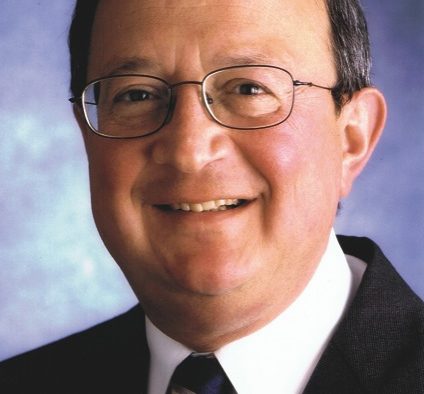An unexpected change
Coming from corporate Australia, Weinman had been the Chief Executive Officer of Laminex Industries and later, George Western Foods. He says that he was just starting to settle into retirement when he got a phone call about chairing a small organisation. The caller, Brian Myerson, said that Weinman had been recommended by David Gonski (Chair of Investec Bank) and Fred Hilmer (Vice President and Chancellor of the University of New South Wales) as someone who could help him turn his “chook raffle into a professionally run organisation”.
Weinman says that he had no intention of getting involved with anything else, but decided to just meet with Myerson, who spoke about his phenomenal, personal success resulting from a double organ transplant. “It was a very motivational meeting,” Weinman said, but he remained hesitant about getting involved.
However, after a doctor told him that transplants had a success rate for one year survival of 90-95 per cent (decreasing by 1-1.5 per cent per year after that), Weinman delved into online research about transplant registrations, with some astonishing results. “Over 130,000 people in Australia die every year from all sorts of causes. And over 50 per cent of Australian drivers are registered donors – that’s over 6 million people, all over 18.” But despite the number of registrations and deaths, only 200 Australians actually donate each year.
Weinman was shocked and began raising awareness about these statistics at every opportunity; from business lunches to breakfasts and dinner with friends. He says that when he would tell people that only 200 organ donations are made a year, “they would get this funny look on their faces like ‘my ears are telling me one thing and my brain is contradicting – it just doesn’t make sense.’
“Then I would tell them that there’s a 95 per cent success rate so we don’t have a medical science problem, we have a supply chain problem.”
A long time expert in supply chain management, Weinman decided to take on the challenge of solving the problem, reaching out for assistance from many high profile individuals.
“Suddenly I had two or three hundred leading Australians, like CEOs of companies, lawyers, media people, sports people who were all floored by this statistic,” and who were ready to help in any way they could.
Second learning
During further research Weinman had what he describes as his second learning: “There are over 70 organisations in the transplant space. So if you do the numbers, there’s 200 donors and 70 organisations – that’s 3 donors per organisation.”
Such fragmentation presents a major hindrance to achieving real results in terms of actual organ donations, Weinman says, despite the large amounts of money that go into these organisations from government funding and donations. “We have less [organ] donors now than we had 20 years ago, since 1989.”
He also began to see many unproductive and ineffective practices inherent in the system, “money wasn’t moving where it was supposed to and it wasn’t coming where it was supposed to.
Determined to be different and solve the problem, Weinman and his supporters decided on four rules:
1. Everyone would work pro bono and that would mean there would be no agendas.
2. There would be only one objective – for Australia to lead the world in making transplants available to anybody who would benefit from it.
3. They would only use business principles to solve the problem and attain their objective, and,
4. The organisation would only work in cross functional teams, such as specialists in medicine, business, law and communication. “In other words we wouldn’t go to the doctors and say ‘Tell us what to do and we’ll do it.’ But we would have a blend of people and they would find the right answers.”
Business solutions
Weinman says they “did what businesses do” to start improving community access to organ donation. “Instead of studying Australia we thought ‘Let’s go and find who does this well, and then analyse why they do it well and what practices they have.'”
Individuals from a number of leading research and consulting firms including Bain & Co, Ernst & Young, Clayton Utz, and PricewaterhouseCoopers contributed pro bono to this study and analysis of global best practice, alongside many others such as governors, doctors, economists.
The results were startling with the study finding that Australians are dying needlessly. It was found that Spain, France and the US have three times the access to transplants that Australians have.
“If we had the same access as them on a per capita basis, then probably over a thousand people a year wouldn’t die that are dying: that’s around a hundred a month.
“We also found out that people were not making informed decisions. There were a lot of myths and misinformation around. There’s a lot of fragmentation – you have more than 70 organisations,” none of whom he says were “big enough to actually run with the whole solution: they’re all competing with each other.”
The problem, Weinman says, is that after examining best practice overseas it appears that our efforts in Australia have been misdirected.
“All we’ve been doing is getting more people to register, but there’s no correlation between registration and donation. So, it’s a misdirected effort, and the systems are blocked.”
Comparing Australia to an overseas counterpart, Weinman says “In 1989, we had the same amount of organ donation as Spain, and then Spain put into a place a nationally co-ordinated system. If we had just kept up with Spain, we would have had 20,000 more transplants.”
The issue, he says, is that too often organisations are driven by inputs and lack set outcomes.
“Nobody knows what the outcomes are,” he says. “There has to be a standard, by which performance is measured. The community space doesn’t have that.” In the business world, he says, “The whole system is geared toward letting the [shareholders] make informed decisions. We have ASIC who tells us when, how, what to report. We have independent auditors who make sure all of the numbers are [legitimate].
“The whole system is driven by outcomes and the shareholders then make decisions as to where to put their money based on [good] information.”
Speaking to Weinman, it becomes clear that ShareLife is incredibly focused on delivering measurable outcomes.
Impressive results
Two years of careful research and analysis from studying systems overseas culminated last year in a strong funding commitment from the government.
Weinman says that at the end of the research process, all of the information was sent to the Prime Minister at the end of April last year.
Then, on 3 July, Prime Minister Kevin Rudd got “COAG [Council of Australian Governments] approval for $150 million to put into place the practices that we gave them; that we catalogued, exactly word for word.” Such approval normally takes up to four years to attain, Weinman says.
The Prime Minister said at the time that the government was proposing a “Commonwealth funding package of $151.1 million, including new funding of $136.4 million over four years to boost the number of life-saving organ transplants for Australians.
“The package developed has drawn together the best international evidence and practice, as well as the expertise of stakeholders such as the Transplantation Society of Australia and New Zealand, the Cognate Committee on Organ and Tissue Donation, and ShareLife.”
Next steps
Weinman says that along the way, ShareLife has had amazing people rallying around a national objective “for Australia to lead the world in making organ and tissue transplants available for all who would benefit.”
The organisation is currently expanding its efforts beyond transplantation and organ donation. “We’ve now got more and more people who want to become involved. And we’re starting to now look at new projects.
“We’re working on obesity [and] three other projects simultaneously because we have that many people who want to work like this and contribute to the community in a different way.”
Weinman says, however, that it is essential to maintain good outcomes through efficient and careful methods. “We still have to make sure that the people implement this properly, because if they don’t we won’t save lives.”
















































































































































